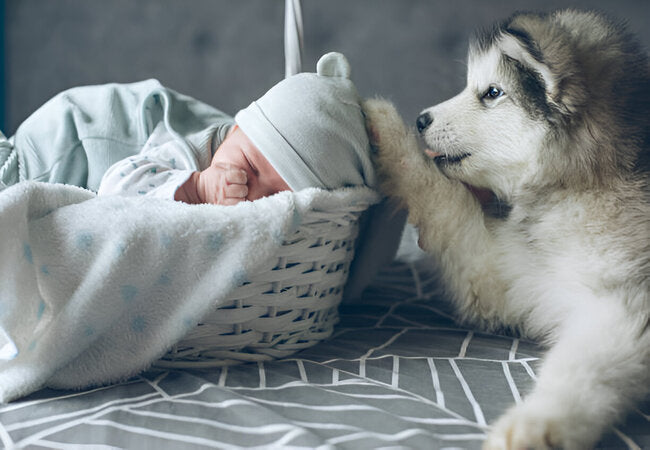Vet‑Approved 2025: Debunking Common Myths About Pets & Newborns 🍼🐾

In this article
Vet‑Approved 2025: Debunking Common Myths About Pets & Newborns 🍼🐾
By Dr. Duncan Houston BVSc
Welcoming a newborn is a joyful yet challenging time for families, and myths about pets can add unnecessary stress. In 2025, veterinarians emphasize understanding the facts to create a safe, happy home for both babies and pets. This in-depth, vet‑approved guide tackles the top myths, lacking science, but causing anxiety. Let's sort fact from fiction and build trust, harmony, and security together! 🐶👶🐱✨
1. 🧠 Myth: Pets Can “Sense” a Baby Before Birth
Many believe dogs or cats can magically detect pregnancy. The truth is, pets react to environmental changes—like schedule shifts, new items, and less owner interaction—not fetal signals.
- What matters: gradual routine adjustments and scent exposure to prepare your pet.
- Vet‑approved approach: introduce crib, stroller, and baby sounds weeks before arrival, using treats to create positive associations.
2. 🧹 Myth: Litter Boxes Are Safe for Pregnant Moms
Many minimize the risk, assuming washing hands is enough. But cat litter can harbor Toxoplasma gondii, a serious threat to unborn babies.
- Risks: Even microscopic contaminated particles can infect.
- Vet‑approved solution: Pregnant women should avoid litter cleaning entirely. Delegate to a partner or use automatic, sealed systems with proper disposal.
3. 🙀 Myth: Cats May Smother Babies in Cribs
This alarming claim is folklore, citing 18th-century superstition. In reality, cats seek warmth and soft textures, not to harm.
- Risk: accidental suffocation is extremely unlikely, but unsupervised sleeping with pets is not recommended.
- Vet‑approved approach: Keep animals out of cribs and supervise any interaction. Install cat‑proof barriers if needed.
4. 🐕 Myth: Pets Instinctively Accept Babies as Part of the Pack
Contrary to belief, newborns can upset pet routines: new sounds, smells, crying, and disrupted schedules trigger stress, not bonding.
- Vet‑approved advice: Prepare pets gradually with gear, sounds, smells, and steady routines. Introductions should be controlled and supervised.
5. 🚼 Myth: Litter Box & Pet Hygiene Don’t Affect Babies
Dirty pet areas can harbor pathogens beyond toxoplasmosis—bacterial and parasitic contamination risks infants and family members.
- Vet‑approved precautions: Clean litter boxes daily, disinfect floors, and practice handwashing. Create designated “no migration” zones between pet and baby areas.
6. ⚠️ Myth: No Need to Prepare Pets Before Baby Comes
Waiting until baby’s arrival to train pets—such as to ignore baby gear or crawling child—is asking for trouble.
- Vet‑approved protocol: Begin obedience training early—cover boundaries, settle anticipation around baby items, and use desensitization with baby sounds.
7. 👪 Myth: Pets & Babies Can Be Left Unsupervised
No matter how calm the dog or cat, unsupervised access to infants is risky. Sudden noises, movements, or curiosity can lead to accidents.
- Vet‑approved safety: Always supervise. Use baby gates, separate rooms, and leash when necessary—especially during naptimes and feeds.
📋 Myth‑Busting Reference Table
| Myth | Reality | Vet‑Approved Tip |
|---|---|---|
| Pets sense the baby early | They detect changes, not pregnancy | Introduce baby items & routines early |
| Litter is safe for pregnant moms | Toxoplasma risk exists | Avoid litter handling during pregnancy |
| Cats may smother infants | Rare folklore; accidental risk is minimal | Keep pets out of the crib, and supervise |
| Pets accept babies naturally | They may feel stressed or displaced | Desensitize and train before arrival |
| Unsupervised pet–baby time is safe | Even calm pets pose a risk | Always supervise and separate when needed |
📱 Ask A Vet App 2025 Support
- 📹 Video review: Share your home setup or pet–baby interaction footage for personalized advice and red‑flag alerts.
- 🧩 Integration plans: Receive step‑by‑step guidelines for introducing pets to pregnancy, gear, and newborns.
- 💬 Live coaching: Get real‑time guidance during key transitions—first introduction, tummy time, or crawling stage.
❤️ Final Thoughts
Myths around pets and newborns can cause unnecessary concern. In 2025, evidence‑based preparation—scent, sound, object acclimation, safe zones, and supervision—ensures peace and safety for all. By dispelling these false beliefs and taking proactive steps, you build harmony, trust, and lifelong bonds between your children and animal companions. 🐶👶🐱✨
Interested in printable myth‑buster sheets, prep checklists, or safety signage for your home? Visit AskAVet.com or download the Ask A Vet app for expert-reviewed plans, video support, and live coaching—helping your family flourish with confidence and calm! 🐾






